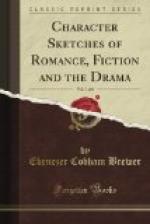ALI BABA, a poor Persian wood-carrier, who accidentally learns the magic words, “Open Sesame!” “Shut Sesame!” by which he gains entrance into a vast cavern, the repository of stolen wealth and the lair of forty thieves. He makes himself rich by plundering from these stores; and by the shrewd cunning of Morgiana, his female slave, the captain and his whole band of thieves are extirpated. In reward of these services, Ali Baba gives Morgiana her freedom, and marries her to his own son.—Arabian Nights ("Ali Baba or the Forty Thieves").
AL’ICE (2 syl.), sister of Valentine, in Mons. Thomas, a comedy by Beaumont and Fletcher (1619).
Al’ice (2 syl.), foster-sister of Robert le Diable, and bride of Rambaldo, the Norman troubadour, in Meyerbeer’s opera of Roberto il Diavolo. She comes to Palermo to place in the duke’s hand his mother’s “will,” which he is enjoined not to read till he is a virtuous man. She is Robert’s good genius, and when Bertram, the fiend, claims his soul as the price of his ill deeds, Alice, by reading the will, reclaims him.
Al’ice (2 syl.), the servant-girl of dame Whitecraft, wife of the innkeeper at Altringham.—Sir W. Scott, Peveril of the Peak (time, Charles II.).
Al’ice, the miller’s daughter, a story of happy first love told in later years by an old man who had married the rustic beauty. He was a dreamy lad when he first loved Alice, and the passion roused him into manhood. (See ROSE.)—Tennyson, The Miller’s Daughter.
Al’ice (The Lady), widow of Walter, knight of Avenel (2 syl).—Sir W. Scott, The Monastery (time, Elizabeth).
Al’ice [GRAY], called “Old Alice Gray,” a quondam tenant of the lord of Ravenswood. Lucy Ashton visits her after the funeral of the old lord.—Sir W. Scott, Bride of Lammermoor (time, William III.).
Alice Munro, one of the sisters taken captive by Indians in Cooper’s Last of the Mohicans (1821).
ALICHI’NO. a devil in Dante’s Inferno.
ALICIA gave her heart to Mosby, but married Arden for his position. As a wife, she played falsely with her husband, and even joined Mosby in a plot to murder him. Vacillating between love for Mosby and respect for Arden, she repents, and goes on sinning; wishes to get disentangled, but is overmastered by Mosby’s stronger will. Alicia’s passions impel her to evil, but her judgment accuses her and prompts her to the right course. She halts, and parleys with sin, like Balaam, and of course is lost.—Anon., Arden of Feversham (1592).
Alic’ia, “a laughing, toying, wheedling, whimpering she,” who once held lord Hastings under her distaff, but her annoying jealousy, “vexatious days, and jarring, joyless nights,” drove him away from her. Being jealous of Jane Shore, she accused her to the duke of Gloster of alluring lord Hastings from his allegiance, and the lord protector soon trumped up a charge against both; the lord chamberlain he ordered to execution for treason, and Jane Shore he persecuted for witchcraft. Alicia goes raving mad.—Rowe, Jane Shore (1713).




